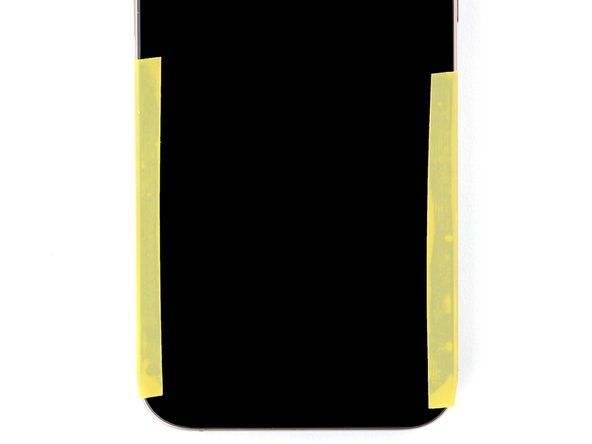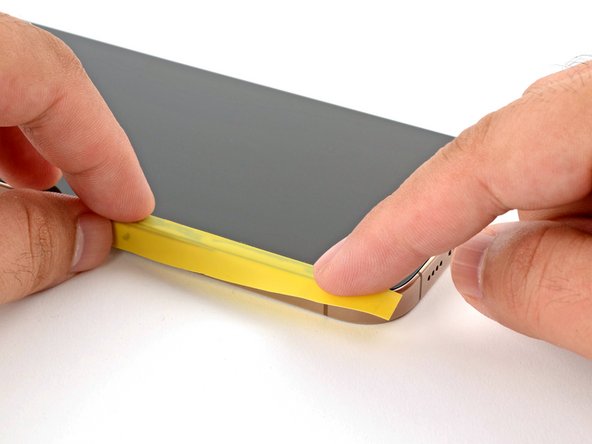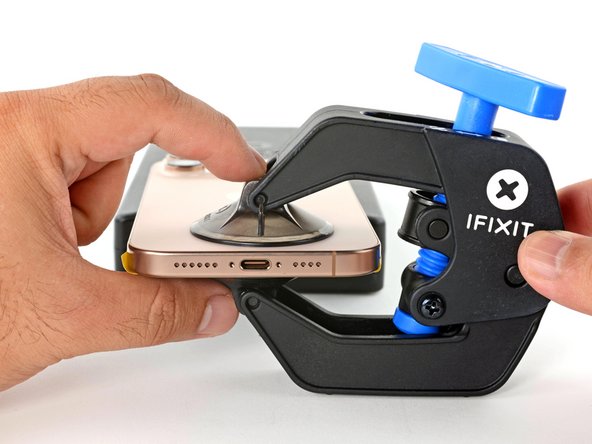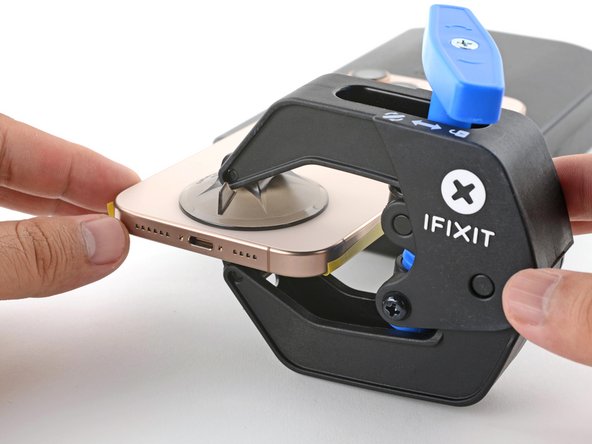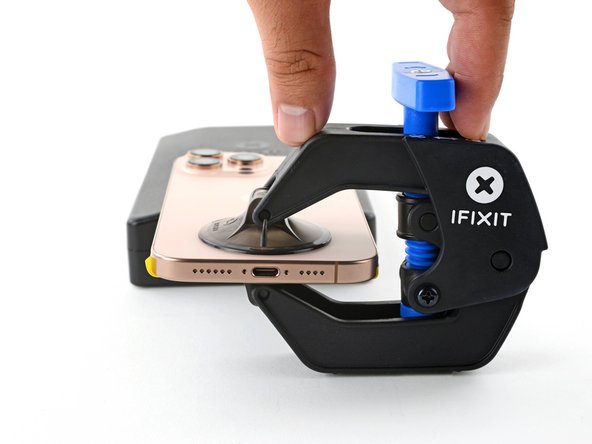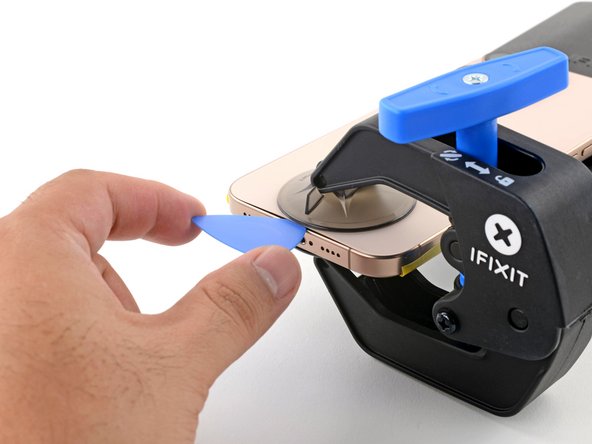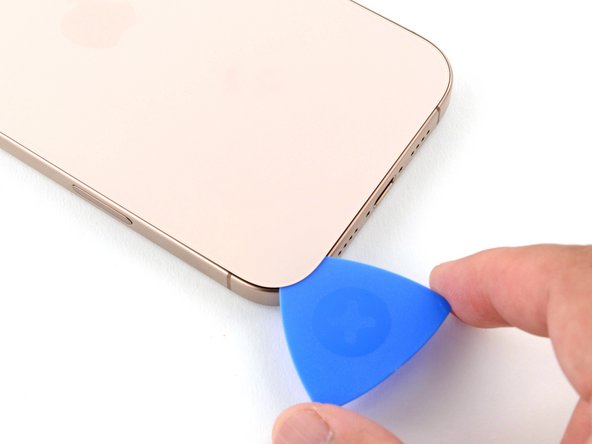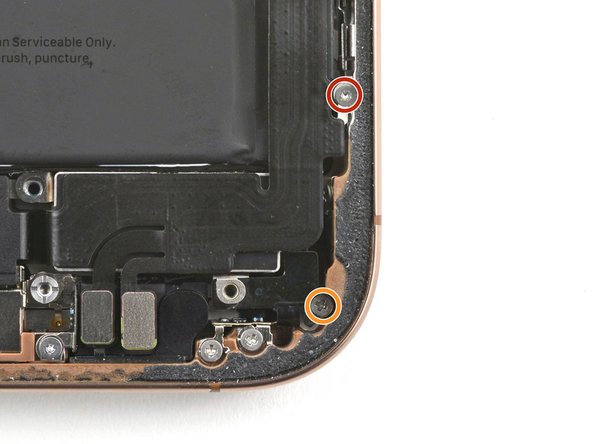DIY Guide to Replace iPhone 16 Pro Max Bottom Microphone: Step-by-Step Tutorial
Duration: 45 minutes
Steps: 40 Steps
Ready to tackle that bottom microphone replacement on your iPhone 16 Pro Max? If your phone’s been struggling to catch your voice or has been a bit moody, it might be time for a new microphone. Don’t forget to grab some replacement back glass adhesive to make sure everything sticks perfectly. And if your shiny new microphone doesn’t come with its own adhesive gasket, be sure to snag one too. Let’s get this repair done and bring your voice back to life! If you need help, you can always schedule a repair.
Step 1
Let that iPhone battery dip below 25%! A fully charged lithium-ion battery can be a bit of a drama queen when it comes to safety.
– First things first, let’s disconnect your iPhone from any cables. Give it a little freedom!
– Now, press and hold the power button along with either the volume button, then slide to turn off your iPhone. Easy peasy!
Step 2
Ensure there’s a nice, clean spot near the bottom edge that’s spacious enough for a suction cup to make its home.
– If your screen or back glass is looking a bit worse for wear, grab some packing tape and lay down some overlapping strips over the glass. It’ll help keep you safe and make taking things apart a breeze!
Tools Used
Step 3
– Grab your trusty P2 pentalobe driver and let’s tackle those two 7.4 mm-long screws hanging out on either side of the charging port. You’ve got this!
Step 4
Don’t push the pick too far in, or you’ll risk damaging your device. Mark your pick here to avoid any mishaps.
Feel free to mark the other corners of the pick with different measurements.
Or, you can tape a coin 3 mm from the tip of the pick for extra precision.
– Measure 3 mm from the tip and mark the spot with a permanent marker. You’re doing great!
Step 5
Get ready for some fun! The next four steps will introduce you to the Anti-Clamp, our nifty tool that makes opening up your device a breeze. If you’re not rocking the Anti-Clamp, no worries! Just skip down four steps for another way to tackle it.
The Anti-Clamp works its magic by applying suction to both the screen and the back glass. If you’re only looking to pop open the back glass, just tape down the screen to keep it secure. And if you want to dive deeper, we’ve got a full guide on how to properly use that tape.
Want the complete scoop on using the Anti-Clamp? Check out our detailed guide right here.
Just a little reminder: make sure the tape is only holding down the screen and not the back glass. We want everything to stay in its place!
– Snip off two strips of tape, stick them along the long edges of your iPhone, and then fold them over the screen to keep everything nice and secure.
Step 6
If your iPhone is slipping out of the Anti-Clamp’s grip, just slap some tape on it for extra hold.
– Give that blue handle on the Anti-Clamp a little tug backward to set those arms free!
– With the back glass looking up at you, slide those arms over the right edge of your iPhone. Place one suction cup on the back glass and the other on the screen. Make sure those cups are centered near the bottom edge for maximum grip.
– Keep your iPhone steady and level while nestled between the Anti-Clamp’s arms—a small box does the trick nicely!
– Now, squeeze those cups together to create a solid suction. You’ve got this!
Step 7
No tape? No problem! Warm up those suction cups to get them sticking. If you need help, you can always schedule a repair.
– Give the blue handle a gentle nudge forward to lock those arms in place.
– Now, twist that handle a full turn (360 degrees) or until you see those cups start to stretch out.
– As the cups stretch, keep an eye on their vertical alignment. If they start to slip, no worries! Just remove the Anti-Clamp and stick some tape on those cups to keep them in line.
Step 8
Make sure not to heat the iPhone too much—the battery’s got a thing for staying cool!
If you don’t see a gap after a minute, don’t fret! Just add a little more heat and give that handle a quarter twist. Let the Anti‑Clamp do its magic while you kick back and relax.
– Grab a hair dryer or heat gun and warm up the bottom edge of the back glass until it’s warm and cozy to the touch.
– Give it up to a minute for the adhesive to take a break and a gap to show up between the back glass and the frame.
– Slide an opening pick into that gap like a pro.
– Remove the Anti-Clamp using those handy pull tabs on the suction cups.
– Skip the next two steps. You’ve got this!
Tools Used
Step 9
In the next couple of steps, we’ll show you how to kick things off by creating a little gap with a suction handle. It’s easier than it sounds!
Feeling a bit chilly? Grab an iOpener to warm up that back glass! Just follow these simple instructions to heat it up and apply the iOpener like a pro.
– Grab a hair dryer or heat gun and warm up the bottom edge of the back glass until it feels nice and toasty.
Tools Used
Step 10
If the edge isn’t giving way, just heat things up a bit more and give it another go!
– Grab a suction handle and stick it to the bottom edge of that back glass like a pro.
– Give it a solid pull with some steady strength to open up a little gap between the back glass and the frame.
– Slide the tip of an opening pick into that gap you just created.
Tools Used
Step 11
As you carefully cut through the adhesive holding that lovely back glass in place, remember to keep your pick no deeper than 3 mm. We want to ensure you steer clear of any sensitive areas below!
– Be careful with that delicate cable connecting the back glass to your iPhone, right next to the volume up button. It’s a bit shy, so avoid inserting your pick here to keep it safe and sound.
– Look out for those multiple spring contacts around the perimeter of your iPhone. They’re just hanging out, waiting for you to give them some attention!
Step 12
If the adhesive is putting up a fight, give it a little heat for about a minute and then give it another go.
– Glide the opening pick along the bottom edge to slice through the adhesive.
– Keep the opening pick in the bottom-left corner to stop the adhesive from resealing.
Step 13
– Grab a hair dryer or heat gun and gently warm up the left side of the back glass until it’s nice and toasty.
Tools Used
Step 14
Keep your pick within 3 mm to steer clear of any accidental damage to those delicate spring contacts!
As you go along, you’ll feel and hear those metal clips pop free. If you need help, you can always schedule a repair.
– Pop in a second opening pick at the bottom-left corner, snug up against your first pick.
– Gently slide your pick along the left edge to break free of that pesky adhesive and unclip those metal clips.
– Keep that pick in the top-left corner to make sure the adhesive doesn’t sneak back in and seal up again.
Step 15
– Grab your trusty hair dryer or heat gun and give some love to the top edge and top-right corner of that back glass. Heat it up until it’s nice and toasty to the touch!
Tools Used
Step 16
Keep your pick within 3 mm to avoid messing with those delicate spring contacts. If you need help, you can always schedule a repair.
– Pop a third opening pick into the top-left corner like a pro.
– Gently glide that pick along the top edge and around the top-right corner, pausing just above the volume up button.
– Keep this pick in place to stop that pesky adhesive from sealing back up.
Step 17
– Grab your trusty hair dryer or heat gun and gently warm up the right edge of that back glass until it feels nice and toasty to the touch.
Tools Used
Step 18
Keep it chill and don’t go deeper than 3 mm with your pick to protect those spring contacts. If you need help, you can always schedule a repair
– Pop a fourth opening pick into the bottom-right corner.
– Swing the pick around the corner and up the right edge, stopping just before the volume down button.
– Leave this pick in place to keep the adhesive from sticking back together.
Step 19
Alright, at this stage, the back glass should be all set and free from the frame. If it seems a bit stubborn, just take your pick and gently go around the edges again to see if there are any sneaky bits of adhesive or clips holding it back. You’ve got this!
– Gently swing the back glass to the right side of your iPhone to break free from any stubborn adhesive holding it down.
– Give the back glass some support with a clean, sturdy object to keep it safe and sound.
Step 20
– Grab your trusty tri-point Y000 driver and let’s get those screws out! Start by removing the three screws that are holding the battery connector cover in place:
– Two screws that are 1.3 mm long
– One screw that’s 1.0 mm long
Step 21
– Gently lift off the cover that protects the battery connector and set it aside.
Step 22
– Use a spudger to gently pry up and unplug the battery press connector.
– To reconnect press connectors like this one, align carefully and press down on one side until it clicks, then do the same on the other side.
Tools Used
Step 23
– Grab your trusty tri-point Y000 driver and let’s tackle those four screws keeping the back glass connector cover snug as a bug:
– Two screws measuring 1.3 mm in length, ready to be unscrewed.
– And don’t forget those two 1.0 mm long screws, just waiting for their turn!
Step 24
– Gently lift the back glass connector cover straight up and pop it off like a champ!
Step 25
– Grab your trusty spudger and gently nudge it under the back glass connector to pop it up and disconnect it. Easy peasy!
Tools Used
Step 26
Now’s the prime time to give your iPhone a test drive! Hook up the battery and back glass just for a bit, power it on, and ensure everything’s running smoothly. Then power it back down and get back to reassembly. If you need help, you can always schedule a repair
– Pop off the back glass.
– When putting it all back together:
– Follow this guide to stick the adhesive and set your back glass in place.
Step 27
– Grab your trusty Phillips screwdriver and let’s tackle those three screws holding the Taptic Engine cover in place:
– One screw that’s 2.9 mm long
– One screw that’s 1.3 mm long
– One screw that’s 2.4 mm long
Step 28
– Grab your trusty tweezers or just your fingers and gently lift the top edge of the Taptic Engine cover.
– Once the bottom edge pops free from the frame, go ahead and take off the Taptic Engine cover.
– When you’re putting it all back together, just make sure that bottom edge clicks back into place with the frame.
Tools Used
Step 29
– Grab your trusty spudger and gently nudge up that lower assembly cable to disconnect it from the logic board. You’ve got this!
Tools Used
Step 30
– Grab your trusty spudger and gently pop up and disconnect the two connectors hanging out near the bottom right edge of the frame. If you need help, you can always schedule a repair.
Tools Used
Step 31
– Let’s get started by unscrewing the two screws that are holding down the lower assembly cable:
– First up, you’ll need to tackle one 1.0 mm-long tri-point Y000 screw.
– And don’t forget that one 1.3 mm-long Phillips screw waiting to be removed!
Step 32
– Grab your trusty hair dryer and give that lower assembly cable section above the Taptic Engine a warm hug until it’s nice and toasty!
Tools Used
Step 33
– Gently slide an opening pick under the lower assembly cable to separate it from the Taptic Engine.
– Carefully bend the cable out of the way so you can access the Taptic Engine. If you need help, you can always schedule a repair.
Step 34
– Grab your Phillips screwdriver and pop out the 2.1 mm screw holding down the Taptic Engine. If you need help, you can always schedule a repair.
Step 35
– Grab your trusty spudger and gently lift that corner bracket up like you’re showing it the best dance moves!
Tools Used
Step 36
– Use the tip of an opening pick to gently slide along the top edge of the Taptic Engine and lift the plastic buffer strip stuck to it. If you need help, you can always schedule a repair
Step 37
Watch out for the battery! Prying against it can lead to trouble.
– Grab your trusty spudger and gently nudge up the Taptic Engine. It’s like giving it a little nudge to say, ‘Hey, time to come out!’
– Now, go ahead and lift out the Taptic Engine. You’ve got this!
Tools Used
Step 38
– Let’s get started by taking out the three screws that are holding the bottom microphone in place:
– One 3.4 mm-long standoff screw
– One 3 mm-long standoff screw
– One 1.4 mm-long tri-point Y000 screw
Step 39
Hey there! Be gentle with that battery—prying too hard might cause some damage!
As you work on it, you might notice a bit of resistance when the microphone pops out of its cozy frame gasket. Just keep at it!
– Grab your trusty spudger and gently lift up the bottom microphone with its flat end. You’re doing great!
– Now, carefully detach the bottom microphone from its spot. Awesome job!
Tools Used
Step 40
– Time to put everything back together!
– Grab your tweezers or just use your fingers to peel away that old adhesive gasket from the bottom of the frame. It’s like peeling a sticker, but way more satisfying!
– If your shiny new microphone comes with a pre-installed adhesive gasket, just take off the liner to reveal the sticky side. Easy peasy!
– If your replacement microphone is missing that lovely gasket, no worries! Simply apply a fresh one to either the frame or the microphone itself.
– Now for the fun part! Angle that microphone down and gently press it into place on the frame, then give it a little push to make sure it’s snug. You’re almost done!
Tools Used












